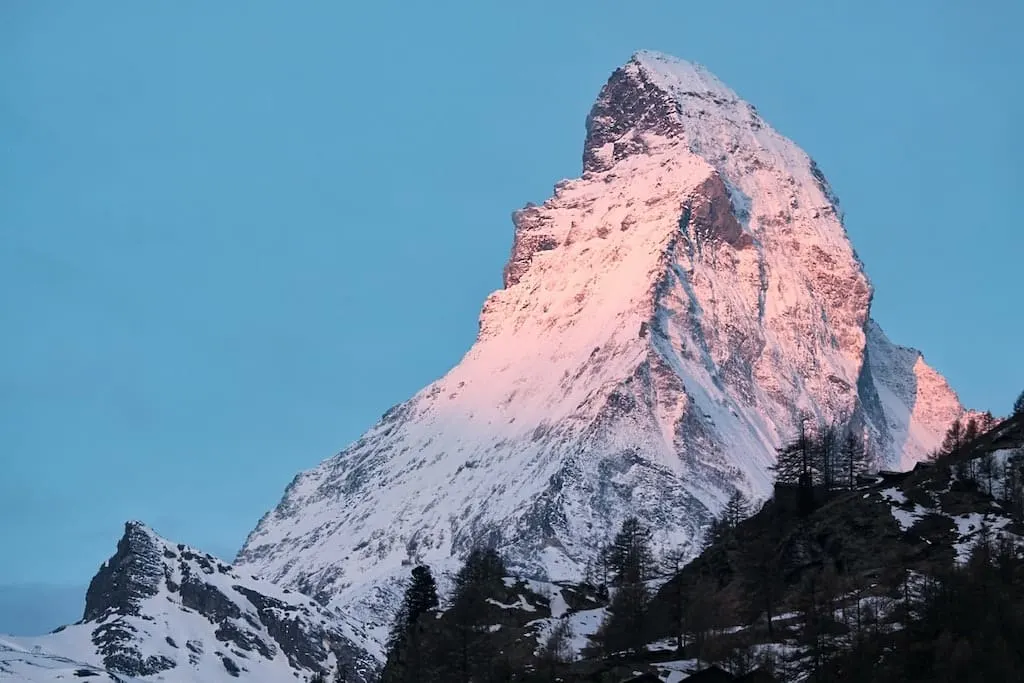Expert travel storyteller Jordan Adkins, founder of InspiredByMaps.com, brings a decade of adventures across 101 countries and 450+ UNESCO sites into rich, off-the-beaten-path narratives, melding ecological expertise with genuine, seasoned travel insights. His full bio can be found here.
Switzerland is one of the world’s most inspiring travel destinations, a nation of abundant and infinitely beautiful locations from snow-covered mountaintops and pristine lakes to striking castles and historic churches. Not to mention Europe’s largest waterfall…
There is so much to see here. It can all seem a little overwhelming — but discovering the most famous landmarks in Switzerland is an excellent place to start…
There is so much to places to visit in Switzerland; you could spend a lifetime explore its riches and only just scratch the surface. This is why we have developed this cheat sheet to help you with your travels.
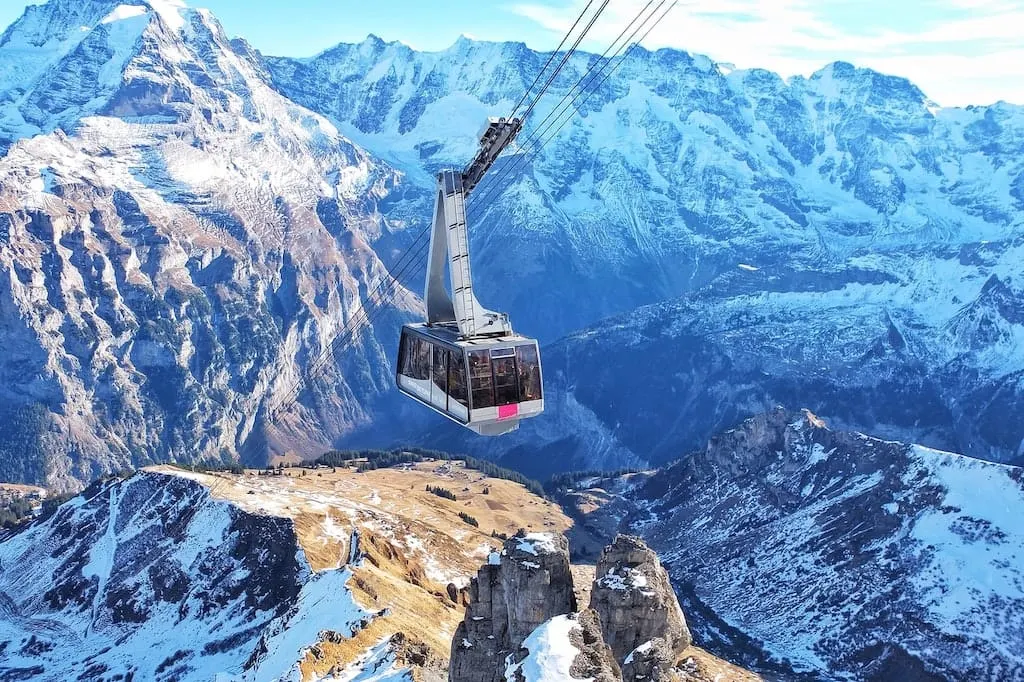
But first – what is a landmark?
A landmark is a recognizable natural or artificial feature that typically stands out from its environment and has become a local or national symbol. For modern tourists, a landmark is useful for navigation – in terms of both being a physical waypoint and in trying to help you organize your itinerary.
Getting the off-the-beaten-track is all well and good, but at the end of the day – there are some spots you just have to see when you visit a country. Think about the Great Wall of China or La Sagrada Familia in Spain. Instantly recognizable places you couldn’t miss if you tried. And Switzerland has more than its fair share…
When approaching a trip to this enchanting land, you will want to tick off as many famous Swiss landmarks as you can – and the best way is to do that is often by taking a tour, getting a Swiss Rail pass, or hiring a car to get around. Public transport can also be used to get to most places and is part of what makes exploring Switzerland so fun and easy.
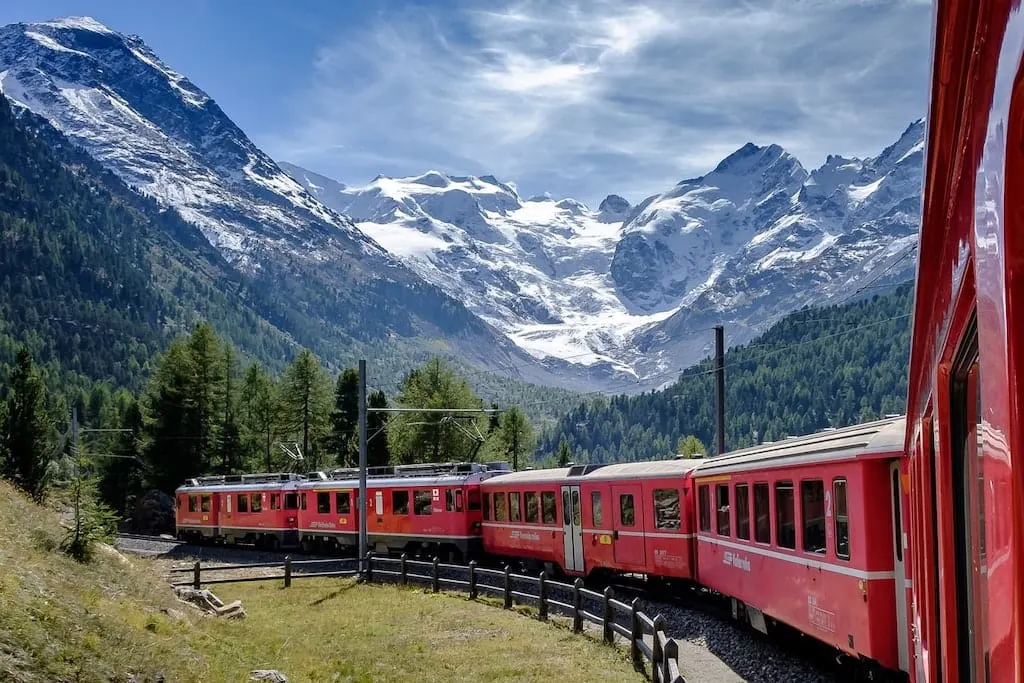
There is a lot to explore in Switzerland — and no list of iconic Swiss landmarks could ever be exhaustive. But, we have tried to get the top highlights by putting a call out to our favorite travel bloggers and asking them to regale us with stories and helpful tips about their best-loved.
This way, you have a reasonable frame of reference to inspire your Switzerland travels from which you could choose a few landmarks that you absolutely cannot miss… or cram as many as possible into one trip.
If you plan it right — and have enough time—, you might just hit them all. And discover plenty more of your own highlights of Switzerland while you’re at it!
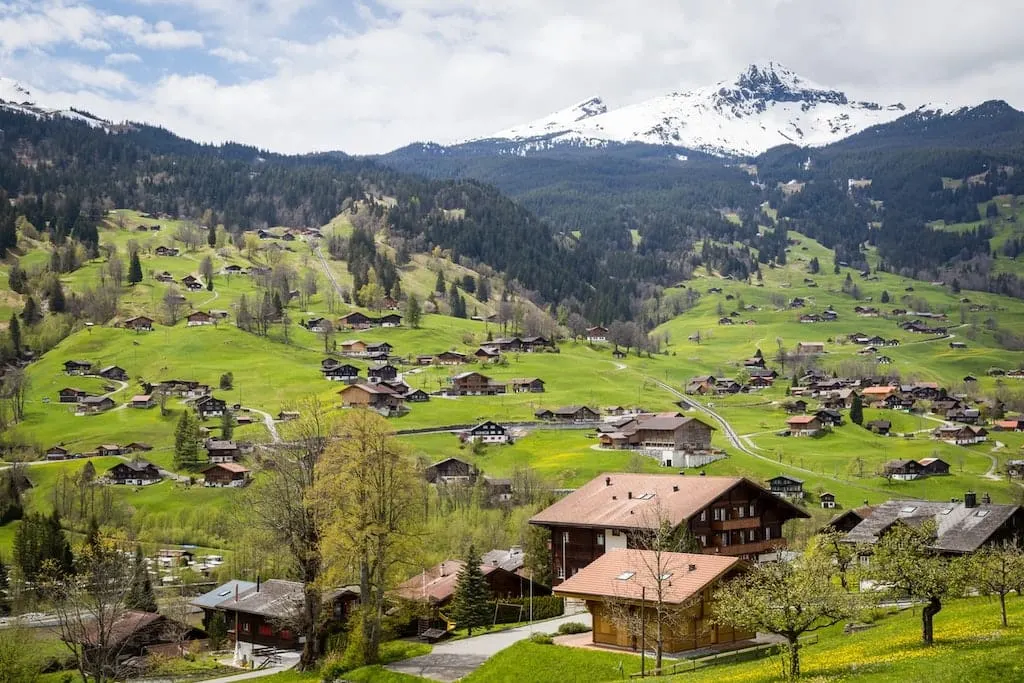
Page Contents
- Castles In Bellinzona
- Chapel Bridge In Lucerne
- Chillon Castle
- Gelmerbahn Funicular
- Gruyere Medieval Castle
- Jet D’eau Geneva
- Lavaux Vineyard Terraces
- Mount Pilatus
- Mount Titlis
- Olympic Museum In Lausanne
- Rhine Falls
- Schilthorn-Piz Gloria
- Schäfler Ridge
- Sphinx Observatory At Jungfraujoch
- St Peterskirche In Zurich
- The Abbey of St Gall
- The First Cliff Walk In Grindelwald
- The Glacier Express Trainline
- The Lion Monument In Lucern
- The Matterhorn
Castles In Bellinzona
Located in Switzerland’s Italian-speaking canton Ticino, Bellinzona is a historic town that is home to three castles, Castelgrande, Montebello, and Sasso Corbato, the best-preserved castles in Switzerland. These castles have been listed as the UNESCO World Heritage Site.
These three grand fortresses are one of the best-hidden gems in the country, with fewer foreign tourists coming here than to world-famous sites such as Zermatt or Schilthorn. However, many people from German-speaking cantons of Switzerland come to Bellinzona because of its unique atmosphere and the southern flair that is significantly different from French and German-speaking parts of Switzerland.
The castles had been built in the area of dispute between the Swiss and Italians who had always fought over its control, and to this day, the three castles that are collectively known as “Tre Castelli” are considered one of the best fortification examples in the Southern Alps.
When you come to Bellinzona, make sure to leave at least half a day to be able to tour the three castles and check out their museums. After the tour, head to Old Town Bellinzona for some lunch and more sightseeing. Walk along Viale Della Stazione, the city’s busiest street lined with stores, restaurants, and small cafes.
Bellinzona is a great stop if you are making your way through Switzerland to Italy. It acts as a getaway for travelers making their way north to Switzerland and the other way around. The town is located at the intersection of roads to St. Gotthard, San Bernardino, and Lucomango passes, a busy thoroughfare in Southern Switzerland.
Explored by Daria Bachmann from the Discovery Nut
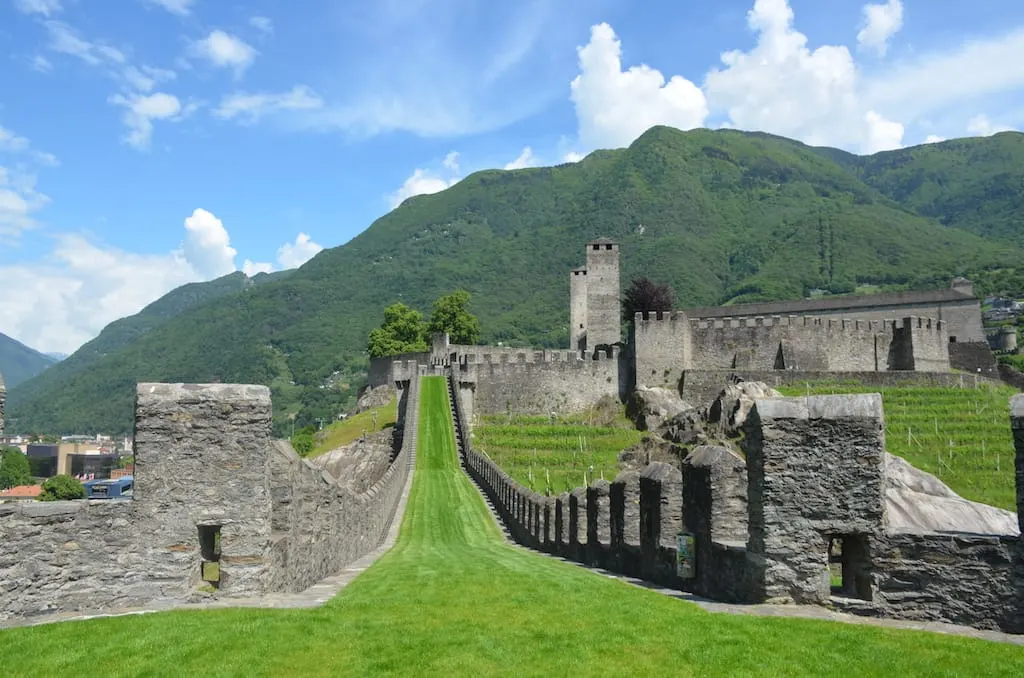
Chapel Bridge In Lucerne
Switzerland is not all about delicious Swiss chocolate, expensive watches, or scenic landscapes. This beautiful country features many historical architectures and landmarks also. One of these is Kapellbrücke, also known as the Chapel Bridge, a popular landmark in Switzerland. It is located in Lucerne and named after the nearby St. Peter’s Chapel.
The iconic covered style and the wooden construction make it an architectural masterpiece and one of the best tourist attractions in Lucerne. This old pedestrian bridge was built in 1333 and has historical significance. It was built over the Reuss River to connect the right part of town with the new part on the left. The purpose was to protect Lucerne from any attack from the southern part.
This historical Chapel Bridge contains some amazing interior paintings dating back to the 17th century. Although two-third of the paintings were destroyed in a fire in 1993 and few of them were successfully restored. There is a Water Tower which is also a part of the bridge. It was previously used as a prison, now it stands on the water and enhances the beauty of the bridge; however, it is not opened for the public now.
When Chapel Bridge was built, its length was around 200 meters. Over the year, numerous shortenings and river bank replenishments reduce the length to only 170 meters. Getting to Capel Bridge is very easy. Lucerne is well connected with all the major cities of Switzerland by train and road.
No extra trip is that there is no entrance fee to access the bridge. Please remember, from January to early February; the paintings are replaced with modern carnival-themed pictures. During this period, you cannot see any historical paintings.
Explored by Trijit Mallick from BudgetTravelBuff
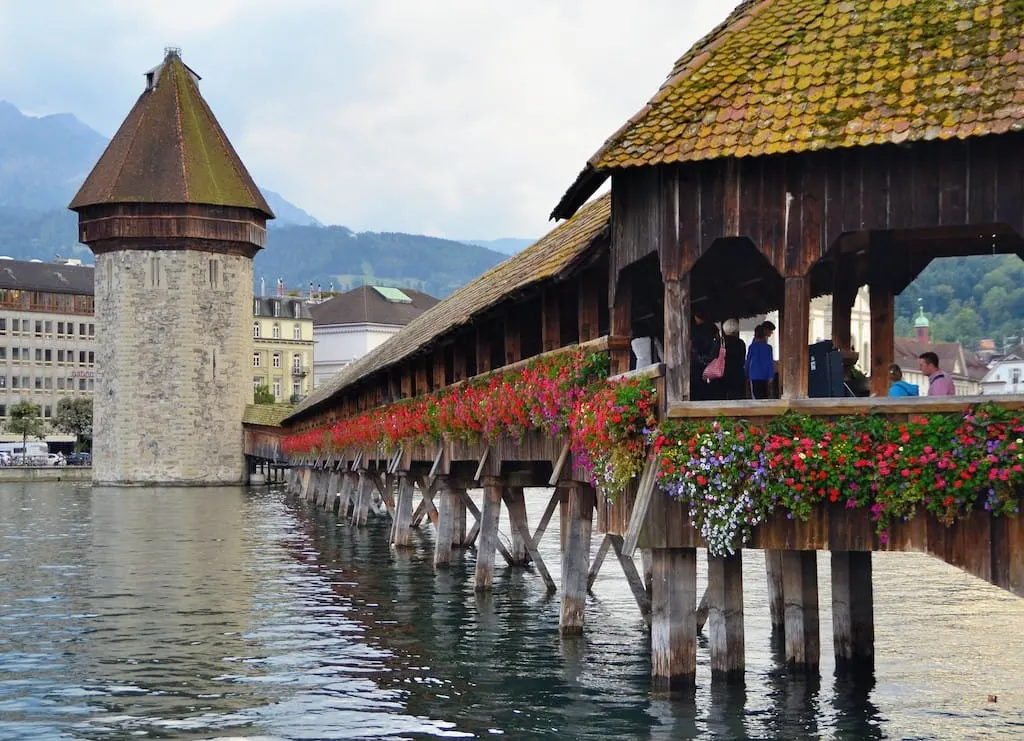
Chillon Castle
Chateau de Chillon is said to be one of the most visited tourist sites in all of Switzerland. It is a stunning castle, in an equally stunning location on a small rocky island in Lake Geneva. However, not only is this a gorgeous castle, but there is plenty to explore in the various rooms in the medieval building.
Chillon Castle was originally built in the 12 century but has been revived many times over across the centuries. Today more than 400,000 visitors come each year to see the wall painting from the 14th century, the subterranean vaults, parade halls, and the bedroom, which has been preserved in its original form, dating back to the time of Bernese rule.
Visitors can choose to wander the castle alone, take a guided tour, or rent an audio tour, which provides information about the various rooms. The castle includes a dungeon/cellar, four great halls, three courtyards, and a series of rooms and stairwells. Several of the rooms have been restored to what they would have once looked like many centuries ago.
You need at least a few hours to explore all the rooms in the castle, even half a day, if you want to check out every corner of this historical beauty.
The castle is located at Avenue de Chillon 21, 1820 Veytaux, and is easy to reach by taking bus 201 to the Chillon stop. For the more scenic route, take a ferry across Lake Geneva to the Villeneuve Gare terminal. Chateau de Chillon is open daily from 9 am to 7 pm.
Explored by Melissa from Queensland Camping
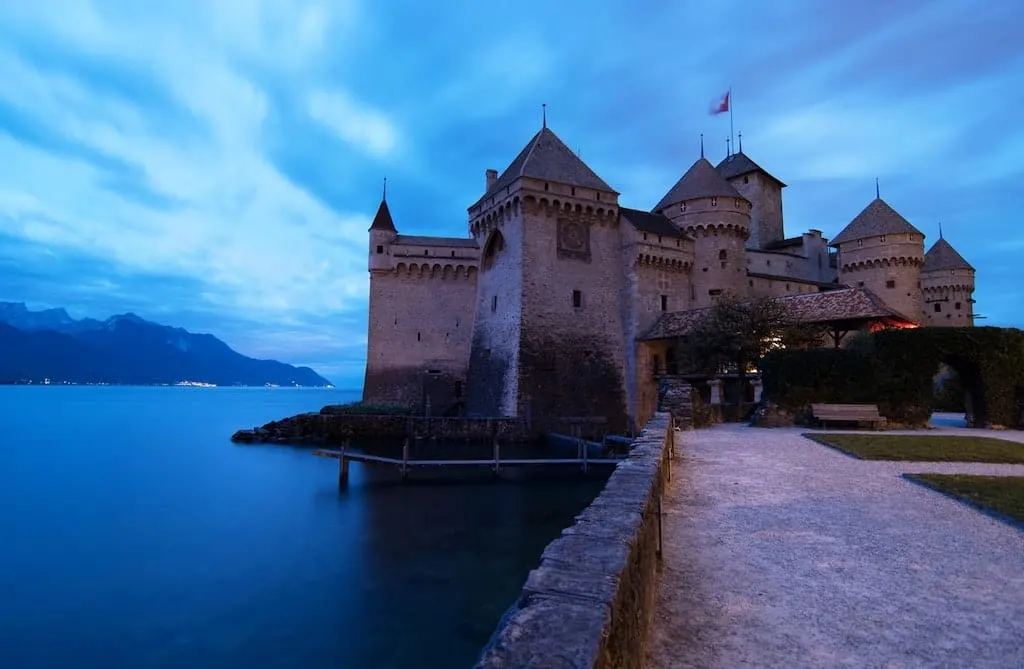
Gelmerbahn Funicular
If you’re looking for famous (and fun!) landmarks in Switzerland, you need to add the Gelmerbahn funicular and Gelmersee lake to your trip.
The Gelmerbahn funicular is in the Swiss Alps and is one of the steepest funiculars (mountain railways) in the world. The gradient at some points is at 106%!!! (Yes- it’s as terrifying and breathtaking as it sounds!). The funicular was originally designed many years ago to help workers get up the mountains – now, it’s a huge tourist attraction.
You can ride the funicular up to visit the breathtaking Gelmersee lake. The color of the water is as turquoise as it looks, and it’s a wonderful place for a picnic and a hike. There are no facilities or cafe up at Gelmersee Lake, so remember to take food and water with you. To get down, either take the funicular down or hike back down the mountain. Don’t forget to visit the incredible suspension bridge near the ticket office- one of the best views in Switzerland!
We recommend visiting the Gelmerbahn funicular during the summer months, as the entire ride is outside, and if it’s raining, you will get wet. The funicular doesn’t run if the winds are too strong, but it does run in the rain, so be careful about when you choose to visit.
The trip up takes about 15 minutes, and you go backwards, facing out into the valley. Be very careful with children- very young children and babies are not allowed due to the risk of falling. However, don’t be scared- it’s a fantastic experience, and if you like rollercoasters, you’ll love this- even if it is a lot slower!
Explored by Kat from Wandering Bird

Gruyere Medieval Castle
Most people associate the name “Gruyere” with a type of delicious Swiss cheese, but there is much, much more to Gruyeres than the cheese. Perched on the top of an isolated hill and towering over the village is the very majestic medieval castle of Gruyeres. It was built in the 13th century by the Count of Gruyeres to control the local area, and throughout the 13th to 16th centuries was home to the different Counts of Gruyeres.
The castle became the residence of the custodians from 1555 to 1798 and then to administration leaders. In 1849 the castle was sold to the Bovy and Balland families. They restored it and used it as their summer home. In 1938 the castle was bought back by the canton of Fribourg and converted into a museum. Today it showcases 800 years of the history of the castle with its special collections of tapestries, paintings, period furniture, towers, ramparts, stained glass windows, and gardens.
The town developed beneath the castle, and today is a very picturesque cobblestoned, well preserved medieval village. In 2014 Gruyeres was declared the most beautiful village in the French-speaking part of Switzerland.
There is an abundance of interesting things to see and do in Gruyeres as well as the medieval castle and village. ‘La Maison Du Gruyere’ is the cheese factory located opposite the railway station and has a very interesting and entertaining tour showing the cheese-making process and history of cheese in the area. The big Maison Cailler chocolate factory is not too far away and also has an excellent tour and tasting.
Gruyeres is about a pleasant two-hour train ride from Geneva, Montreux, or Zurich. Don’t forget to enjoy some of the local specialties while you are here. The traditional Fribourg cheese fondue, the delicious meringues and double cream, the chocolate, and much more delicious food from the Gruyères district.
Explored by Maureen Spencer from So Many Places! So Little Time!
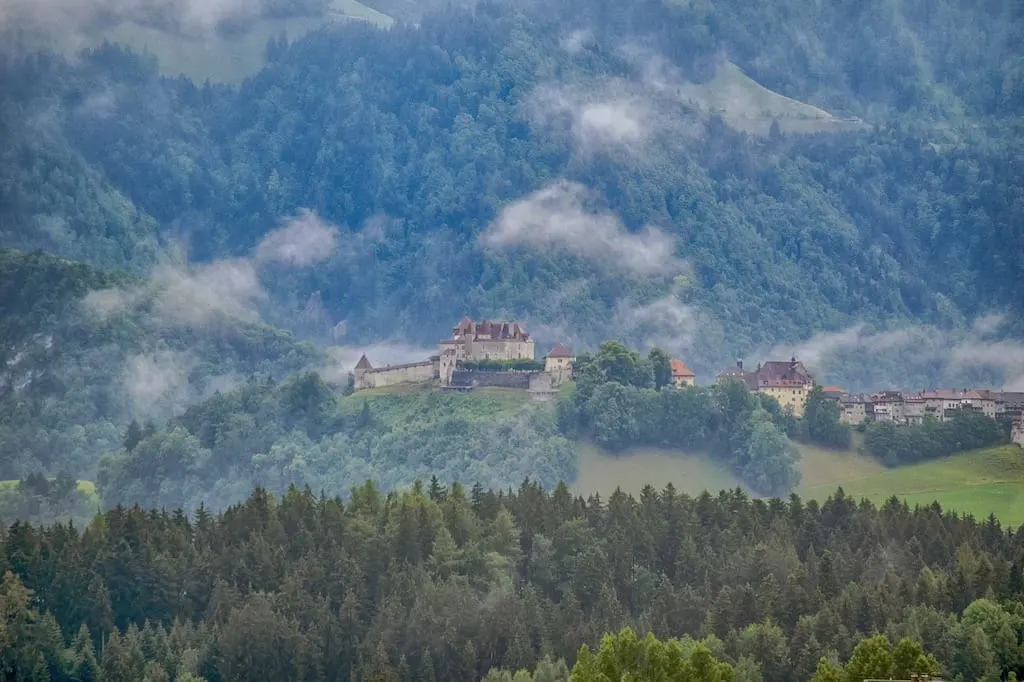
Jet D’eau Geneva
One of the most iconic sights in the beautiful Swiss city of Geneva is the Jet d’Eau (or if translated directly from French “water jet”). This 140 meters high fountain is one of the highest in the world and has been a symbol of Geneva since 1891.
The fountain was originally built as a relief valve for pipes that were supplying water to the city’s jewelry makers. The water (500 liters of lake water a second) shoots at a speed of 200 kilometers per hour above Lake Geneva. The fountain symbolizes the city’s vitality and international status.
The Jet d’Eau is located in Geneva Harbor or “La Rade” just off Eaux-Vives on the left bank. The fountain can be seen from most viewpoints in the city and when coming into land at the airport. The fountain is often lit up at night. It is a key part of the city’s skyline. For the best view, however, head to the Bains de Paquis, where you will get a great selfie with the water fountain.
Note that the fountain does not run all year round as it is periodically closed for maintenance as well as turned off during the night, when there are strong winds and when temperatures dip below zero.
Explored by Tracy from Tracy’s Travels In Time
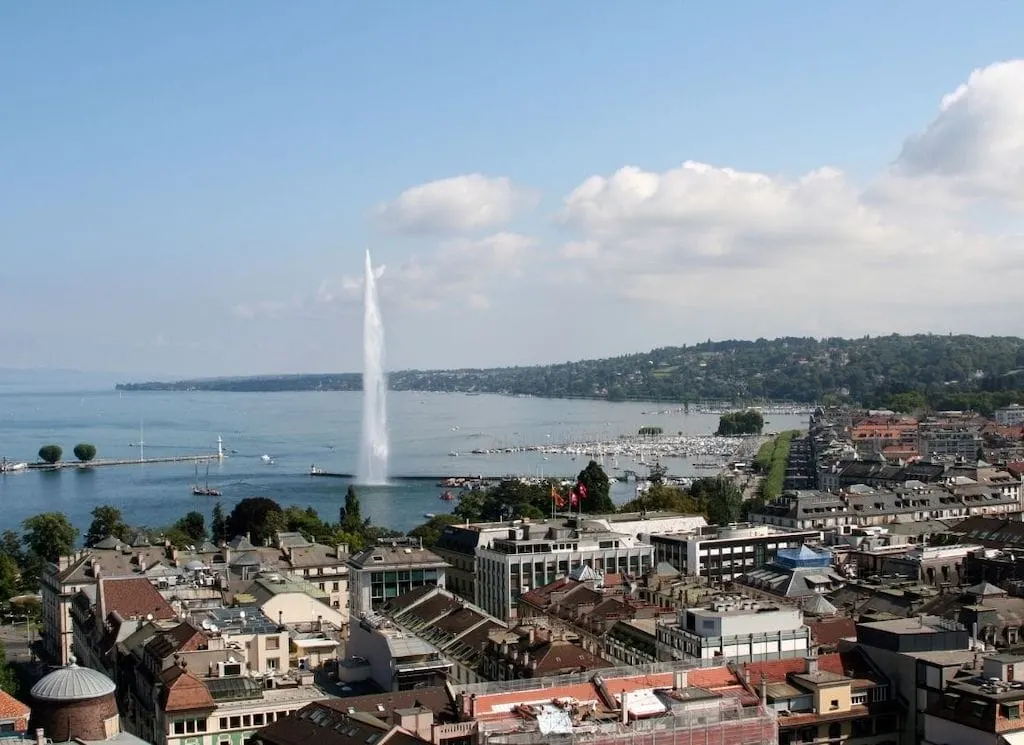
Lavaux Vineyard Terraces
The Lavaux Vineyard Terraces span almost 30 kilometers of lower slopes of the Swiss mountainside along the shores of Lake Geneva, from Chateau de Chillon to the eastern outskirts of Lausanne in the Vaud region.
While there is some evidence that vines were planted in the region in Roman times, the current vine terraces can be documented back to the 11th century, when the region was dominated by Benedictine and Cistercian monasteries. It is an excellent demonstration of a centuries-long relationship between individuals and their climate, designed to maximize local resources in order to achieve a highly regarded wine, which has always been economically important.
The Lavaux vineyard landscape shows the results of centuries of contact in a very particular and fruitful way between people and their climate, optimizing local resources to create a highly appreciated wine that has become an important part of the local economy. aIn the face of rapidly increasing urban developments in recent decades, its insecurity has prompted security initiatives strongly endorsed by local communities – meaning the vineyards are protected as world heritage today and available for future generations to wander through and marvel at.
There are countless places to explore the vineyards, but much like the Climats / vineyards of Burgundy in France or the Vienna-City vineyards; the best way to explore them is by bike on a hot sunny day. Pack a picnic, or stop at any of the many taverns along the way for maximum enjoyment.
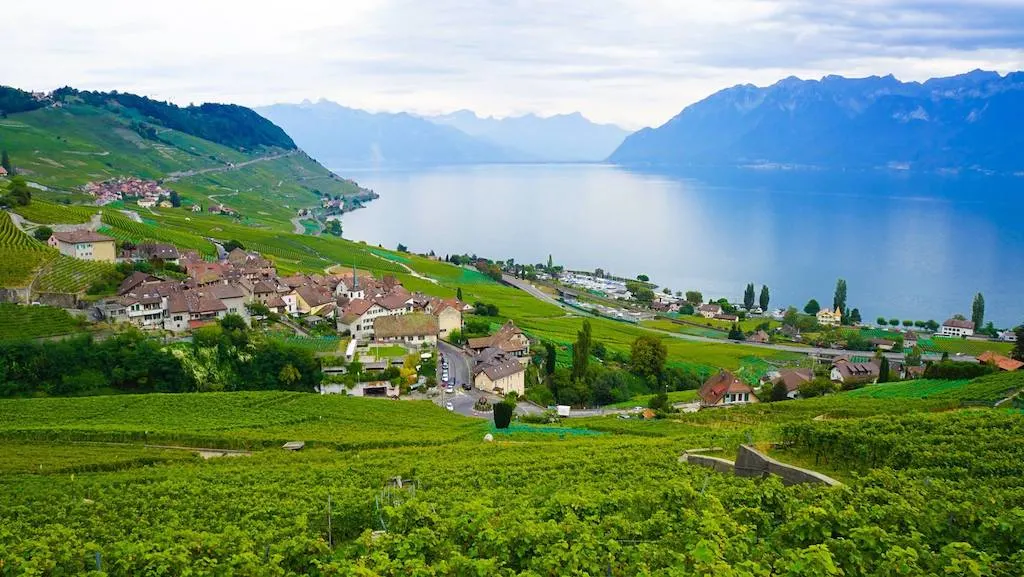
Mount Pilatus
Mount Pilatus borders Lucerne, Switzerland, and has a number of features that make it so iconic!
First, the steepest cogwheel railway ascends the 48% gradient mountainside and has done so since 1889, when the machinery was first exhibited at the Paris World Fair! The 40-minute railway ride begins in Alpnachstad and ends at Pilatus Kulm, the peak of Mount Pilatus (Pilatus Kulm is Mount Pilatus in German). Alternatively, you can ride a gondola, then an aerial cableway, to and from Kriens to Pilatus Kulm. There are combination tickets as well as single way tickets.
Feel free to explore the areas at scheduled intermediate stops where there are numerous activities. During warmer months, you can hike, take a glider ride, complete a ropes course, and families can even rest at a playground. Don’t miss Switzerland’s longest toboggan course in Fräkmüntegg, running 1,350 meters (0.8 miles)! In the winter, go sledding or snowshoeing under the gondola pathway at Fräkmüntegg or Krienseregg.
Each activity is a supplemental cost, so if you’re on a budget, I recommend the toboggan run at $9 per person and saving $80 for the combo experience riding the cogwheel railway to Pilatus Kulm and the aerial cableway/gondola back down to Kriens.
Another reason Mount Pilatus is so famous stems from myths of the Middle Ages about dragons that once lived deep in the cracks of Pilatus. When visiting, take the Dragon Trail to explore the area and stop for the incredible views along the way.
Facilities at the top of Pilatus Kulm are in the hotel. Built in 1890, the hotel boasts stunning views of the surrounding mountains. Grab a bite to eat and watch paragliders beginning their flight from the top of Mount Pilatus!
Explored by Alanna from Periodic Adventures
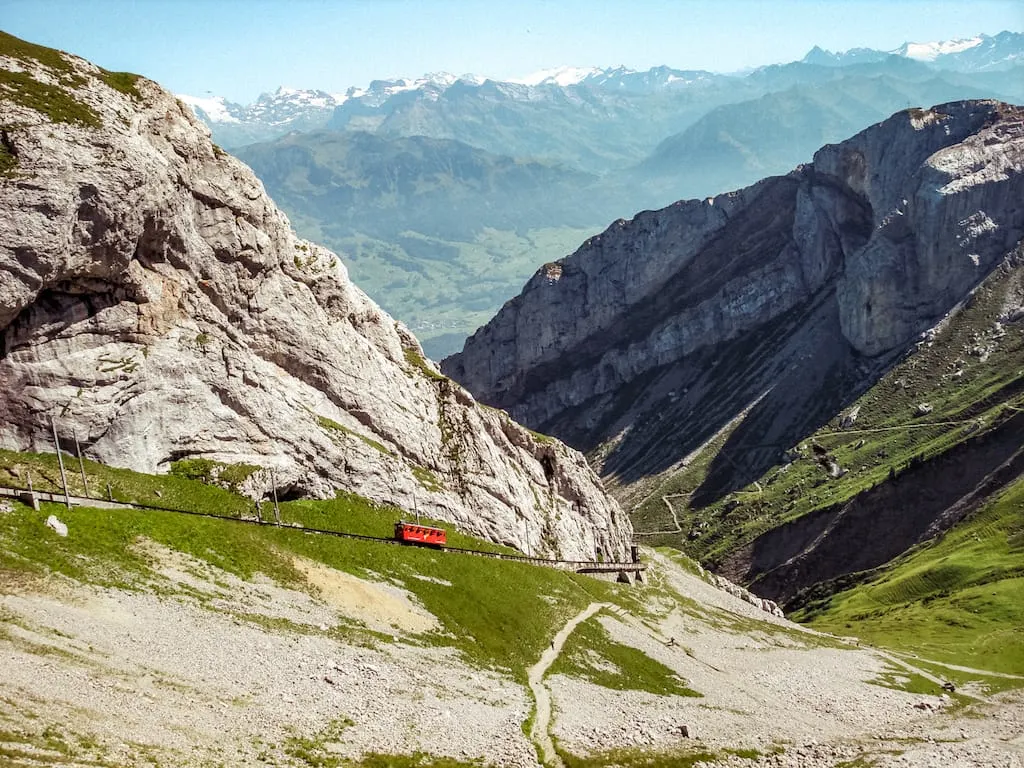
Mount Titlis
A breathtaking glacier, panoramic views over snow-covered Alpine landscapes, a thrilling cliff walk, and a ride on the world’s first revolving aerial cableway – you can experience all on an excursion to Mount Titlis!
Located in Central Switzerland and one of the biggest highlights of the region, Mount Titlis is a mountain at ~3020 m that is perpetually covered in snow. It is the only easily accessible glacier in this region and (rightfully so!) a popular destination for tourists.
Titlis can be reached from the town of Engelberg through a series of cable cars. The first one takes you through Trübsee, a beautiful Alpine lake where you can stop to row a boat and take in the scenic surroundings. The next leg, to the summit of the mountain, is on the famous rotating cable car, the Titlis Rotair. Snowy landscapes surround you – the rotating cable car enables you to see it all! – as you make your journey up the mountain.
At the summit, there are five levels (Swiss engineering at its best!) with lots of activities to do. The best of them are at the top level, where large viewing platforms allow you to take in the panoramic views and play in the snow (even during summer!). Also located here is Europe’s highest suspension footbridge, the Titlis Cliff Walk. Several hundred meters over the glacial abyss, a walk across this bridge is a thrilling experience, and not quite as scary as it may sound!
Another highlight of Mount Titlis is the Glacier Cave built several meters below the glacier. Sub-zero temperatures inside the cave, walls of ice all around, and the knowledge that the ice here is 5000 years old make this cave very enchanting! You should also dress warm since at the summit it’s always winter!
Despite being a popular tourist destination and therefore crowded at times, Mount Titlis is a worthy addition to your Switzerland bucket list! (Just get there early and you won’t need to deal with the crowds!)
Explored by Smita from My Faulty Compass

Olympic Museum In Lausanne
Situated in the town of Ouchy on the northern side of Lake Geneva, just 2km south from the center of the stunning city of Lausanne, the Olympic movement has certainly chosen an exquisite location for its iconic Museum.
Boasting an incredible elevated location, the Lausanne Olympic Museum is worth a visit for the idyllic views across Lake Geneva alone. As you approach the entrance, the pristine gardens make for a fabulous location for several statues, works of art, and mementos celebrating the Olympic Games.
For an entry fee of just CHF 18 for adults and CHF 10 for children, visitors can learn about the original Games of the ancient Greeks and then the foundation of the modern Games by Pierre de Coubertin. It is impossible not to be impressed by the wide range of exhibits, including an Olympic Flag dating back to 1914 and a superb display of Torches from each Games back to Berlin 1936.
Moving down to the ground floor, the Museum next covers the inspirational stories of individual Olympians that have graced the Games. In addition to displays of donated outfits and equipment, look out for the hugely emotional multi-media footage that will inevitably raise the hairs on the back of your neck.
Stretching over 3,000 sq. m over three floors and comprising more than 1,500 objects, you’ll no doubt find a connection to your own personal favorite and be swept up in your own memories of sporting achievement. Even in a country famous for its outdoor splendor, the Olympic Games Museum celebrating the origins of the Games and the many inspirational achievements is more than worthy of a few hours indoors.
Even in a country famous for its splendid Alpine scenery, a visit to the Olympic Museum in Lausanne is a must-do on your Switzerland itinerary.
Explored by Paul from thetwothatdo.com

Rhine Falls
The Rhine Falls at Schaffhausen is the biggest plain waterfall in Europe and a must-see landmark in Switzerland for nature lovers. There is a visitor’s area on both the Northern and Southern sides of the Rhine Falls. To really appreciate them from all angles, it’s recommended to visit both sides. An easy circular hike of about 3,4 km makes this possible.
The Southern bank is dominated by Laufen Castle sitting high above the Rhine Falls. From the castle, there is a trail to different viewing platforms that bring you so close to the cascading water that you can almost touch it. Your ticket to the viewing platforms also allows you to visit the castle.
The Northern bank is dominated by a smaller “castle” called Schlössli Wörth from where the boat rides depart. There are different options, with one allowing you to step onto the rock in the middle of the falls.
There is no fee to visit the Northern bank of the Rhine Falls. This is the area with the most restaurants and souvenir shops. There is also a picnic area with a view on the falls.
If you do the circular hike, it will take you over the train bridge that crosses the river just above the falls. The train stops at Laufen Castle and is a good transport option to consider if you’re coming from Zurich, which is just under 50 km away. You can also combine a visit to the Rhine Falls with a trip to Lake Constance, or Stein am Rhein, a beautiful medieval village a bit further up the river.
Explored by Linda from Travel Tyrol
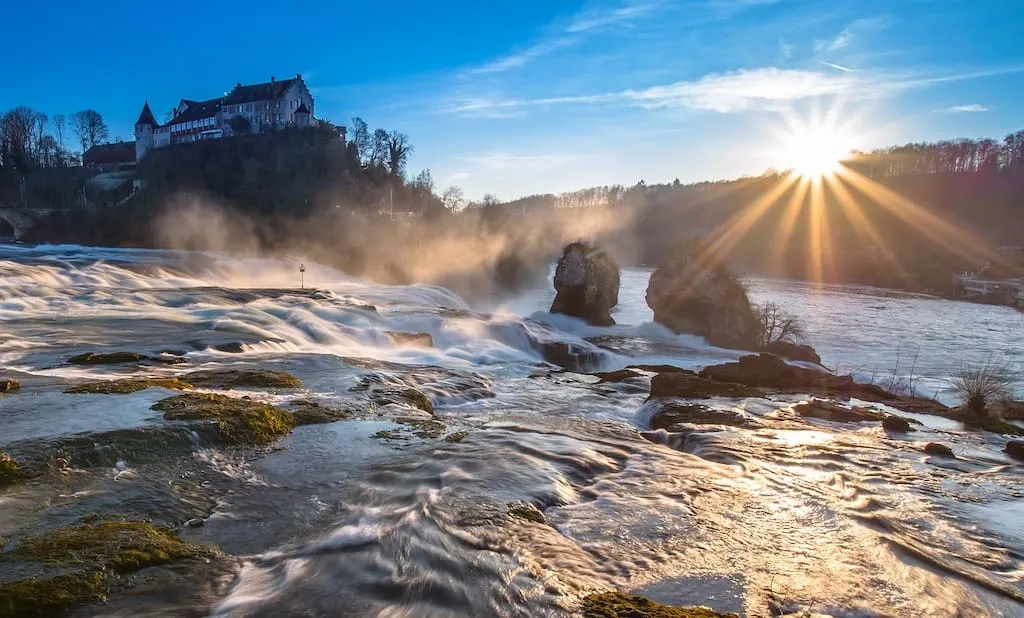
Schilthorn-Piz Gloria
Schilthorn-Piz Gloria is one of the tallest peaks in the Swiss Alps, standing at a whopping 2970 m / 9744 ft high, and is famous as a James Bond filming location, appearing in the 1969 007 film “On Her Majesty’s Secret Service” –
The striking metal structure that stands proudly on the summit houses a 360-degree rotating restaurant, James Bond Hall of Fame exhibit, as well as a massive indoor cinema that plays re-runs of action scenes from the memorable Bond movie. Even if you’re not much of a James Bond fan, Schilthorn-Piz Gloria is still well worth a visit.
Outside the summit house, you’ll find a platform with breathtaking panoramic views of three of Switzerland’s highest peaks: Eiger, Mönch, and Jungfrau, as well as several hiking trails and adventure activities, including a Via Ferrata (mountain-climbing). If adventure activities are not your thing, you can simply marvel at the stunning views or try the James Bond themed champagne Brunch experience in the rotating restaurant, available daily until 2:00 pm.
The nearest town to Schilthorn-Piz Gloria is Interlaken. To reach the summit, you can catch a bus from Interlaken to Stechelberg. If you have access to a vehicle, it’s also possible to drive to Stechelberg. The drive is very scenic and lined with stunning waterfalls. There is paid parking available at Stechelberg station.
From Stechelberg, you’ll board the first (of four) aerial cableways for the picturesque journey up the mountain: Stechelberg – Gimmelwald – Mürren – Birg – Schilthorn. Each cable car offers a unique outlook and stops at some beautiful villages along the way. The journey takes approximately 40 minutes to reach the summit. However, I highly recommend a stop at one of the beautiful mountain villages if time allows. The walk back down to Stechelberg from Gimmelwald or Mürren will guide you through some spectacular green pastures and grazing livestock, and is a must-do experience.
Another attraction to check out at Schilthorn is the spine-tingling Skyline Walk and Thrill walk located at Birg cableway station. Here you’ll have the opportunity to walk along a 200-meter see-through cliff-side pathway with glass floors and sheer drop-offs.
Tickets for the Schilthorn-Piz Gloria cableway cost approximately CHF 108.00 for adults and CHF 54.00 for children – or it’s free to hike!
Explored by Amanda from Bucket List Seekers
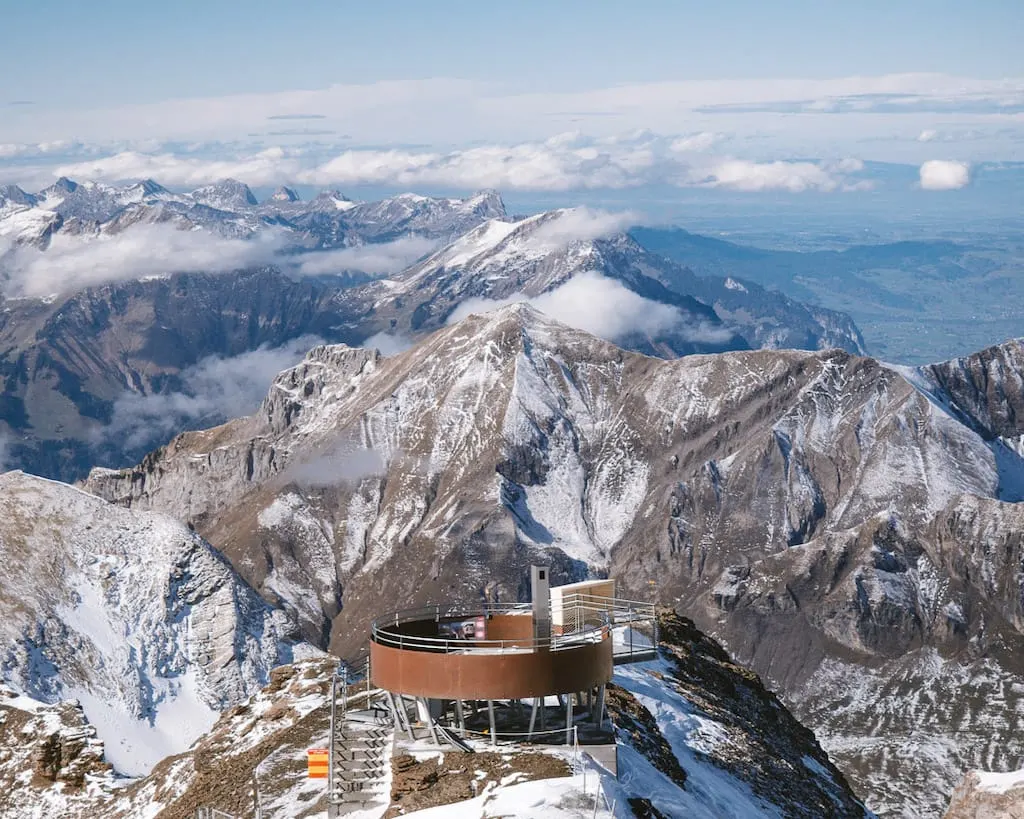
Schäfler Ridge
Hiking up to Schäfler ridge is one of the most scenic hikes in Switzerland. Located 1,920 meters up in the Ebenalp, Schäfler is an insanely beautiful ridgeline from where you can overlook both Austria and Germany (if weather permits, of course).
The hike starts from Wasserrauen, where you can choose between two different options. The first one is to hike all the way up to Schäfler; in this case, the hike distance is around 7.5km with a 1,200m incline, which can be completed in 3-4 hours.
Since there is a cable car station in Wasserrauen, the easiest option is to take the cable car up to Ebenalp then start your hike from there. The cable car costs 20 CHF in one way (31 CHF in return), but in exchange, you only need to hike 3km with approximately 300m incline to reach Schäfler ridge.
Once you make it to Schäfler, you will find a guesthouse on top where you can fuel up with some snacks and drinks. If you want to see the sunset or sunrise from the top, you can also stay in the guesthouse overnight. Booking your place in advance is recommended as it can fill up quickly!
There are many other interesting places to visit in the Ebenalp region, so you can combine your hike to Schäfler ridge with some of them. Berggausthaus Aescher is one of the most famous mountain huts in Switzerland, and even if you take the cable car up, it’s only a small detour to visit it. If you chose to hike all the way down to Schäfler, it’s worth taking the hiking trail that goes through Seealpsee before heading down to the parking lot. It’s a really scenic route, but it’s not for beginners or people with a fear of heights.
Explored by Krisztina Harsanyi from She Wanders Abroad
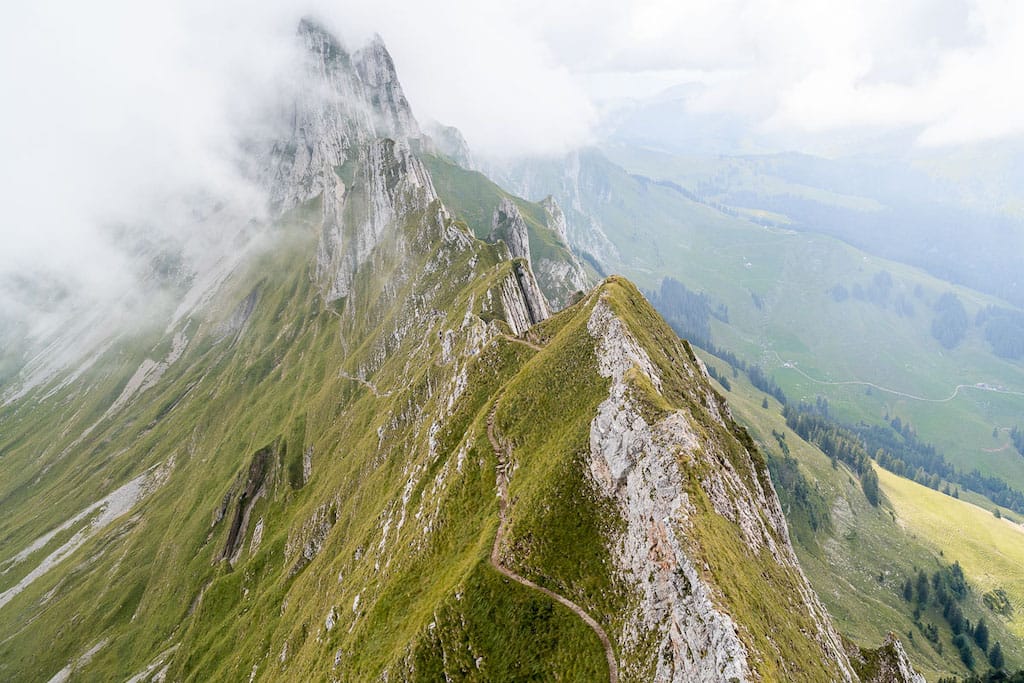
Sphinx Observatory At Jungfraujoch
Jungfraujoch is one of the most famous landmarks in Switzerland, synonymous with the phrase “top of Europe.” In reality, a saddle in the Bernese Alps, in between the Jungfrau and Mönch peaks, since 1912, this spot has been visited by tourists along the famous Jungfrau rack railway line from Kleine Scheidegg.
The railway line to Jungfraujoch is a stupendous achievement of alpine construction. It lies largely in the Jungfrau Tunnel, passing through the solid rock of the Eiger and Mönch mountains, ending at Jungfraujoch station, the highest railway station in Europe. However, with the station itself buried underground, the most distinctive image of Jungfraujoch is the Sphinx Observatory.
The Sphinx Observatory is perched up above the station on a rocky outcrop, one of the highest astronomical observatories anywhere in the world. As well as a scientific observatory, there is also an outdoor observation deck accessible to the public, the second-highest in all of Switzerland. It is reached by an elevator tunneling up from Jungfraujoch station, along with a complex containing multiple restaurants and a post office.
Jungfraujoch is best visited on a day trip along the Jungfrau railway, whether from Interlaken or the smaller mountain villages of Grindelwald or Lauterbrunnen. Ticket packages can be purchased covering each leg of the journey, including entry to Jungfraujoch. Covered by snow year-round, it is best visited on a clear day, to enjoy the beautiful vistas of the surrounding mountains. There’s also an ice palace, snow play area, and the chance to hike on the adjacent glacier.
Explored by Shandos Cleaver from Travelnuity
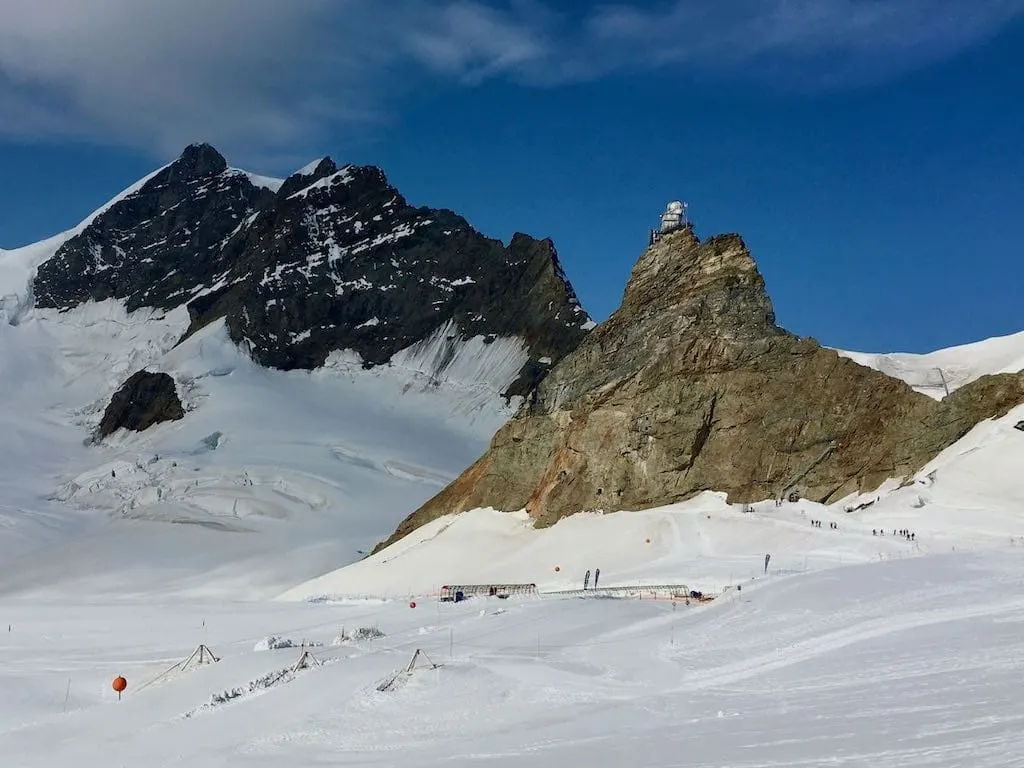
St Peterskirche In Zurich
Globally recognized as the home of quality timepieces, it’s quite fitting that Europe’s largest clock face can be found in Switzerland – it’s a must when spending one day in Zurich!
Centrally located on St Peterhofstatt and built on Roman castle ruins beside Lindenhof Hill, St Peterskirche is the oldest church in Zurich. The small, earliest version of the church was constructed here in the 13th century and has since had many additions over time until the 16th century (its current structure). Staying true to its roots, however, the foundations of St Peterskirch date back to the 9th century.
From 1340 until as recently as 1911, the 64-meter-high clock tower of St Peterskirch was used as a watchtower and lookout to warn the city of fires. Made from over 40,000 shingles, its pitched roof decorated by spires is said to be the only wooden roof in Zurich.
The tower of St Peterskirch is an icon of Switzerland as it proudly boasts the largest clock face in Europe. Each of the tower’s four sides features huge medieval clock faces that have been telling time since the 13th century. For much of these centuries, St Peterskirche was the official Zurich local time that all clocks were accurately set by.
Each clock face measures an impressive 8.64 meters diameter, while the minute hands measure 5.73 meters and hour hands 5.07 meters each. Within the clock tower are five bells dating back to 1880, the largest weighing in at 6 tonnes.
For one of the best places to photograph St Peterskirche, head to Quaibrüke (Quay Bridge) over the Limmat River to capture its stunning clock faces alongside the Fraumünster and twin domes of Grossmünster, equally beautiful landmarks of Zurich!
Explored by Alyse from The Invisible Tourist
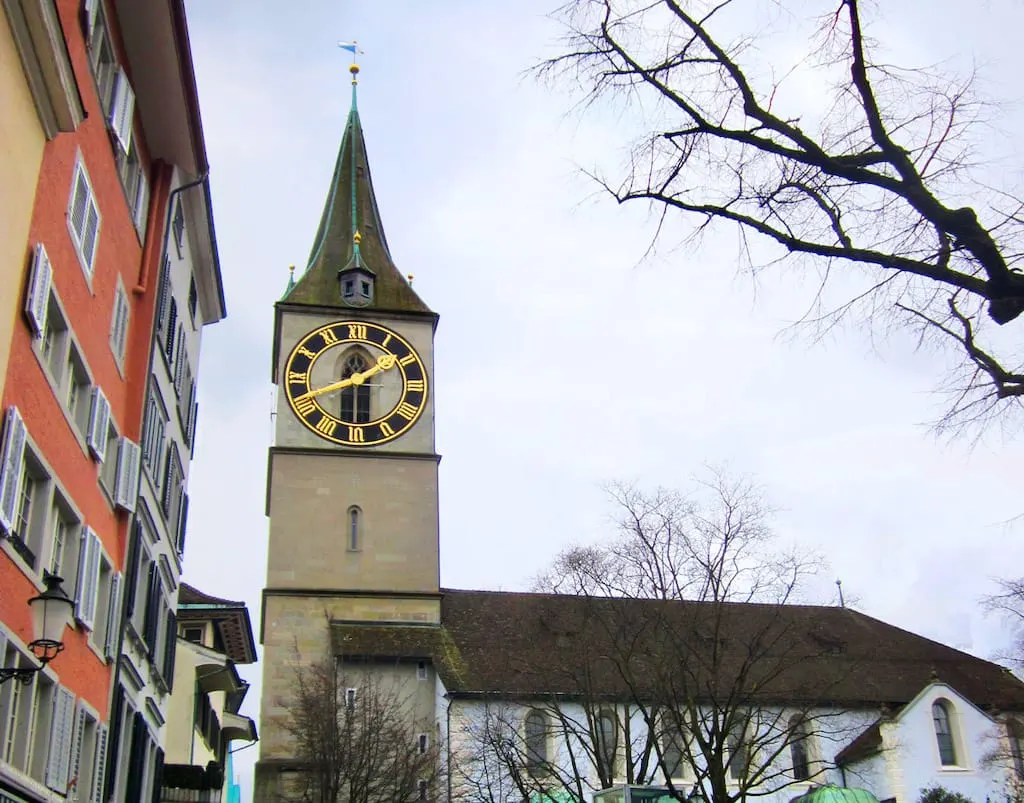
The Abbey of St Gall
The Abbey of St Gall is situated in the north-eastern region of Switzerland, in the town of St Gall, and primarily owes its present design to the 18th-century building campaigns.
It is a spectacular architectural ensemble featuring numerous buildings clustered around the central square of the Abbey: the medieval abbey church (the present cathedral) on the west side, accompanied by two towers and the ancient cloister, that now contains the magnificent abbey library; the ‘Neue Pfalz,’ the new seat of the canton authorities, is situated on the east side. St. Gall’s Abbey is one of the most famous landmarks of Switzerland and not only is an excellent example of a large Carolingian monastery but was also one of the most significant cultural centers in Europe from the 8th century until its secularisation in 1805.
It reflects 1200 years of monastic architectural tradition and is a traditional and exemplary ensemble of a vast Benedictine monastery. Most of the significant periods of architecture, from the High Middle Ages to historicism, are portrayed and protected in an exemplary way. Despite the variety of styles, the humanist ensemble creates the impression of general unity, surrounded on the north and on the west by largely intact buildings of the city of St Gall.
One of the most exquisite representations of its period is the High Baroque Library, and one of the last significant constructions of Baroque abbey churches in the west is the current cathedral. The immeasurable cultural values preserved at the Abbey are of particular significance in addition to the architecture content, particularly: the Irish manuscripts of the 7th and 8th centuries, the medieval manuscripts of the St Gall School of the 9th and 11th centuries, documents relating to the background of the origins of Alemannic Switzerland and the architecture of the convent during the Caroline era.
Extremely beautiful and protected today as UNESCO World Heritage, it is one of my favorite monasteries in Europe – along with the Jerónimos Monastery in Lisbon and the Curtea de Argeș Monastery in Romania.
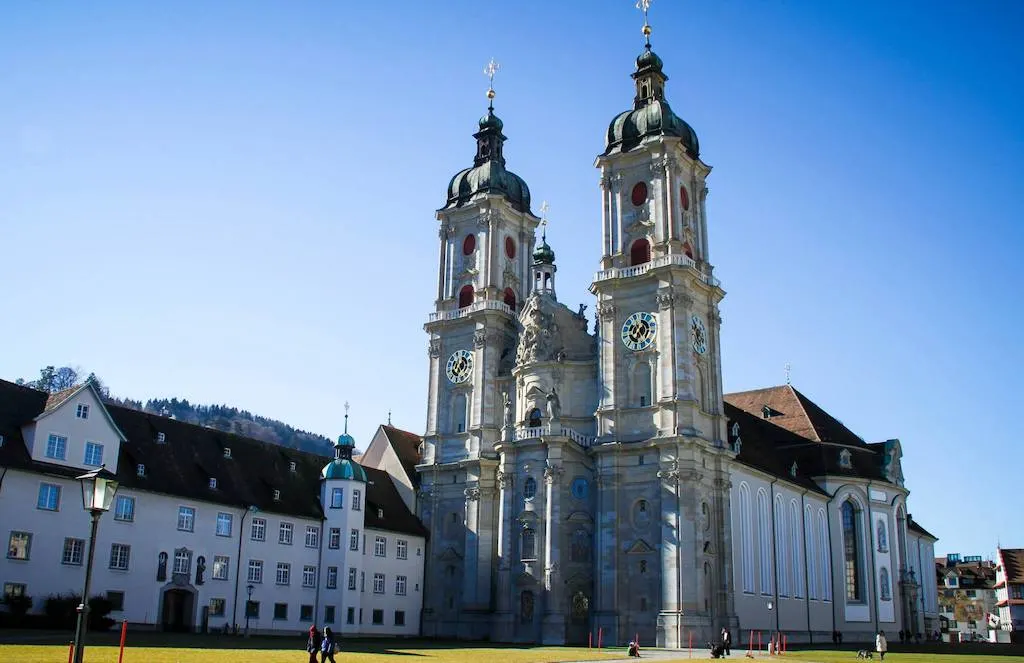
The First Cliff Walk In Grindelwald
Suspended 45 meters out from the cliffs, the First Cliff Walk is an engineering marvel and provides visitors the opportunity to witness a suspended bird’s eye view from this elevated platform. Amazingly the metal structure has been constructed using just a single rope system to suspend the bridge from the rock face and was opened in September 2015.
It was the first of many enticing tourist attractions to open at Grindelwald First. You can also experience exhilarating rides on the First Flyer and First Glider.
The First Cliff Walk itself is a little unnerving as you can see the plummeting cliff faces below your feet, but the phenomenal scenery is worth every step. Take in the soaring Swiss mountains, cascading waterfalls, and the greenest valley below. This is truly one of the most spectacular experiences.
Given the changeable mountain weather, make sure you wear plenty of layers and take a jacket regardless of what the day seems to be like in the village. Temperatures can drop quickly and can get very chilly even in the middle of summer. Getting to the First Cliff walk is pretty simple and depends on your energy levels. The easiest way to arrive is via the Grindelwald First gondola, which whisks you from Grindelwald Village to the top station of First.
If you are fit and healthy, you can tackle hiking to the First Station. From Grindelwald, this is a challenging uphill climb for 8.7 kilometers one way but affords amazing views along the way.
As well as the Cliff Walk, I highly recommend taking a walk to Lake Bachalpsee. One of the most stunning high-altitude lakes, you can walk to Bachalpsee in just one-hour return from First Station.
Explored by Karen from Big Adventures for Little Feet
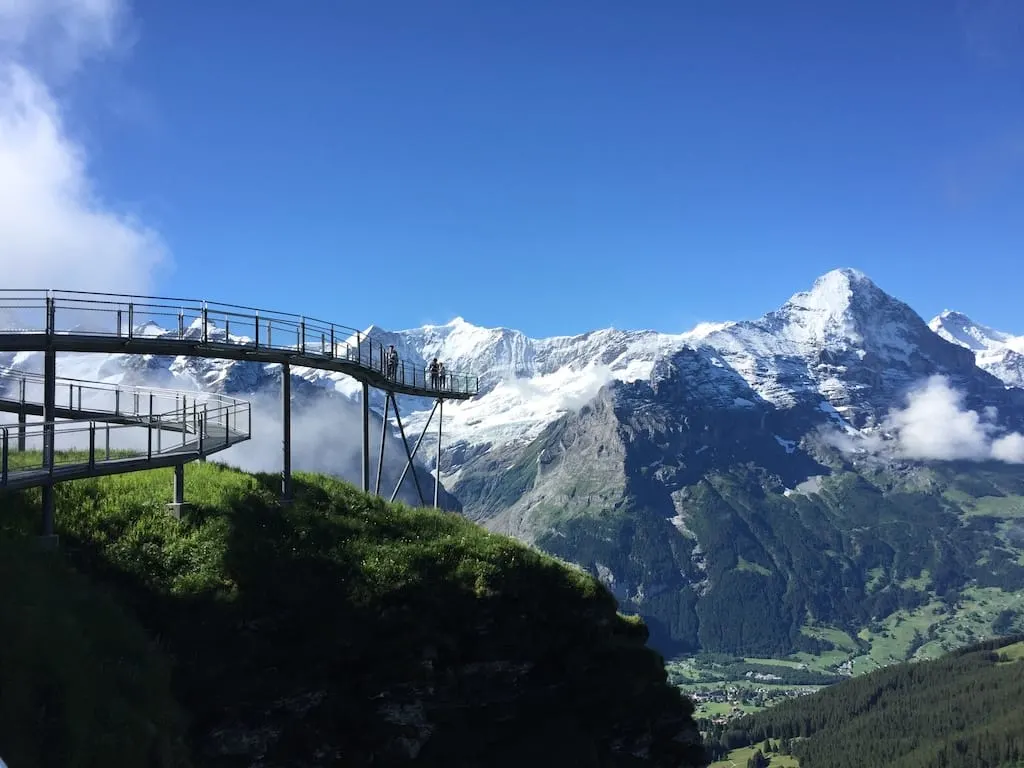
The Glacier Express Trainline
The Glacier Express line is not only a landmark in itself, but it also connects many far-flung landmarks that are otherwise very hard to reach in the Swiss Alps. This includes mountain passes, famous peaks, and even UNESCO world heritage sites.
The route itself begins in Zermatt, a mountain resort just beneath the peak of the iconic Matterhorn, which pyramid shape inspired the Toblerone chocolate bar. It is then a 7-8-hour express train journey to reach St Moritz and the Piz Bernina, the highest mountain in the Eastern Alps. The Glacier Express train is known as the slowest fast train in the world as it is a high-speed train, but due to the mountainous terrain, it is unable to travel at high-speeds for most of the journey.
The most famous scene of the line would be the crossing at Landwasser Viaduct, a UNESCO World Heritage Site, a single-track six-arched curved limestone railway viaduct which was constructed back in 1901. But there is otherwise so much to see along the route, including 291 bridges and 91 tunnels through the 291 kilometers of the railway line and various highlights like the highest point at Oberalp Pass and the Rhine Gorge, which marks the source of the River Rhine.
To visit the Glacier Express, the train ride can be booked individually, but it is also included on local train passes as well as the Eurail/Interrail passes with advance booking required.
Explored by Allan Wilson from ‘It’s Sometimes Sunny in Bangor.’

The Lion Monument In Lucern
One of the most famous landmarks of Lucerne, the Lion Monument is a memorial dedicated to the 1,000 Swiss guards who lost their lives in Paris on August 10th, 1792, while protecting the life of King Louis XVI during the French Revolution.
This imposing Lion carved in stone is visited by over a million people annually. The man behind the vision of constructing this memorial was a Swiss Guard by the name Karl Pfyffer, who by fate on that same day of the tragedy was on leave and visiting his home in Lucerne. After years of service abroad, when he eventually returned home to Lucerne, Pfyffer committed to a vision of completing a monument in honor of those comrades-in-arms who lost their lives.
His vision was only to be realized many years down the line, when his fund-raising initiative had eventually funded the project. A model of a larger-than-life lion was created by a high-profile Danish artist, Bertel Thorvaldsen.
The monument of the dying Lion placed inside a low cliff, surrounded by trees and water, reminds us of this devastating event in history. Mark Twain referred to this monument as “the most mournful and moving piece of stone in the world,” and it truly is.
The Lion Monument is located in the heart of Lucerne, a few steps from Lake Lucerne. Next to it is the Glacier Garden of Lucerne and the Alpine Museum. The entrance to the Lion Monument is free.
Explored by Elena from Passion For Hospitality
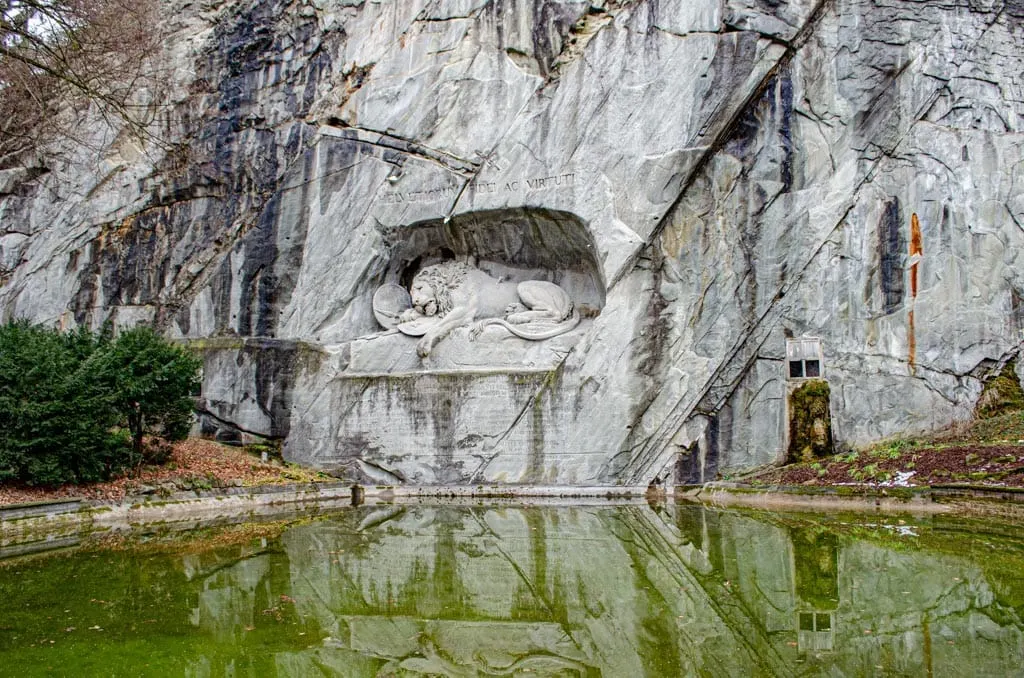
The Matterhorn
One of the most famous landmarks in Switzerland is the Matterhorn, the triangular-shaped mountain peak that rises above the alpine village of Zermatt. At 4,478 meters, the Matterhorn is not the highest peak in Switzerland, but it’s definitely one of the most recognizable.
The Matterhorn was first climbed in 1865, but sadly, on their descent, four of the six-member party fell to their deaths. This brought the Matterhorn to the world’s attention, and it has drawn thousands of visitors – both climbers and non-climbers – to Zermatt ever since.
For those that don’t want to scale the iconic peak, it is possible to get fantastic up-close views by taking one of three excursions from Zermatt. Matterhorn Glacier Paradise (which also offers year-round skiing) and Rothorn can both be reached by cable car, whilst Gornergrat can be reached by cogwheel train. All offer outstanding views of the Matterhorn, and taking one of these mountain excursions is one of the best things to do in Zermatt.
Whilst regarded as Swiss, the Matterhorn actually straddles the border of Switzerland and Italy, and during the winter months, it is possible to ski across the border. A highlight for many visitors to Zermatt is witnessing the Matterhorn bathed in orange when the sun rises in the morning. It’s an incredible sight and one that will take your breath away.
To see the Matterhorn, you’ll first need to travel to the car-free village of Zermatt. Regular train services from all over Switzerland connect to Zermatt, and for those visitors arriving by car, a large public car park is located in the lower village of Tasch with train connections to Zermatt.
Explored by Carolyn from Holidays to Switzerland
